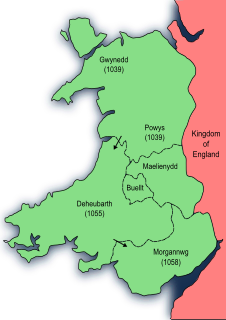Gruffydd ap Rhydderch (d. AD 1055) was a king of Gwent and part of the kingdom of Morgannwg in south Wales and later king of Deheubarth.

Gwent was a medieval Welsh kingdom, lying between the Rivers Wye and Usk. It existed from the end of Roman rule in Britain in about the 5th century until the Norman conquest of England in the 11th century. Along with its neighbour Glywyssing, it seems to have had a great deal of cultural continuity with the earlier Silures, keeping their own courts and diocese separate from the rest of Wales until their conquest by Gruffydd ap Llywelyn. Although it recovered its independence after his death in 1063, Gwent was the first of the Welsh kingdoms to be overrun following the Norman conquest.

Wales is a country that is part of the United Kingdom and the island of Great Britain. It is bordered by England to the east, the Irish Sea to the north and west, and the Bristol Channel to the south. It had a population in 2011 of 3,063,456 and has a total area of 20,779 km2 (8,023 sq mi). Wales has over 1,680 miles (2,700 km) of coastline and is largely mountainous, with its higher peaks in the north and central areas, including Snowdon, its highest summit. The country lies within the north temperate zone and has a changeable, maritime climate.

Deheubarth was a regional name for the realms of south Wales, particularly as opposed to Gwynedd. It is now used as a shorthand for the various realms united under the House of Dinefwr, but that Deheubarth itself was not considered a proper kingdom on the model of Gwynedd, Powys, or Dyfed is shown by its rendering in Latin as dextralis pars or as Britonnes dexterales and not as a named land. In the oldest British writers, Deheubarth was used for all of modern Wales to distinguish it from Hen Ogledd, the northern lands whence Cunedda and the Cymry originated.
Gruffydd was the son of Rhydderch ab Iestyn who had been able to take over the kingdom of Deheubarth from 1023 to 1033. He received the lordship of Caerleon in 1031 and strengthened its fortifications. [1] Already king of part of Morgannwg, Gruffydd became involved with Deheubarth when that kingdom was taken over from Hywel ab Edwin by Gruffydd ap Llywelyn, already king of Gwynedd, in 1044. Gruffydd ap Rhydderch was however able to expel him in 1045 and became king of Deheubarth himself. He was said to be a powerful king who stoutly resisted raids by the Danes and attacks by Gruffydd ap Llywelyn. In 1055 however Gruffydd ap Llywelyn killed him in battle and recaptured Deheubarth.

Caerleon is a suburban town and community, situated on the River Usk in the northern outskirts of the city of Newport, Wales. Caerleon is a site of archaeological importance, being the location of a notable Roman legionary fortress, Isca Augusta, and an Iron Age hillfort. The Wales National Roman Legion Museum and Roman Baths Museum are in Caerleon close to the remains of Isca Augusta. The town also has strong historical and literary associations, as Geoffrey of Monmouth elevated the significance of Caerleon as a major centre of British history in his Historia Regum Britanniæ, and Alfred Lord Tennyson wrote Idylls of the King while staying there.
Hywel ap Edwin was king of Deheubarth in south Wales from 1033 to 1043.

Gruffydd ap Llywelyn was the King of Wales from 1055 to 1063. He was the son of King Llywelyn ap Seisyll and Angharad, daughter of Maredudd ab Owain. He was the great-great-grandson of Hywel Dda.
In 1049 he is reported raiding up the River Severn in alliance with an Irish Viking Fleet. [2]

The River Severn is the longest river in Great Britain at a length of 220 miles (354 km), and the second longest in the British Isles after the River Shannon in Ireland. It rises at an altitude of 2,001 feet (610 m) on Plynlimon, close to the Ceredigion/Powys border near Llanidloes, in the Cambrian Mountains of mid Wales. It then flows through Shropshire, Worcestershire and Gloucestershire, with the county towns of Shrewsbury, Worcester and Gloucester on its banks. With an average discharge of 107 m3/s (3,800 cu ft/s) at Apperley, Gloucestershire, the Severn is by far the greatest river in terms of water flow in England and Wales.
His son Caradog ap Gruffydd (who received Caerleon in 1057 [1] ) also attempted to emulate his father and grandfather by gaining control of Deheubarth but was killed at the Battle of Mynydd Carn.
Caradog ap Gruffydd was a Prince of Gwent in south-east Wales in the time of Gruffydd ap Llywelyn and the Norman conquest, who reunified his family's inheritance of Morgannwg and made repeated attempts to reunite southern Wales by claiming the inheritance of the Kingdom of Deheubarth.
The Battle of Mynydd Carn took place in 1081, as part of a dynastic struggle for control of the Welsh kingdoms of Gwynedd and Deheubarth. The result of the battle had a radical effect on the history of Wales.




